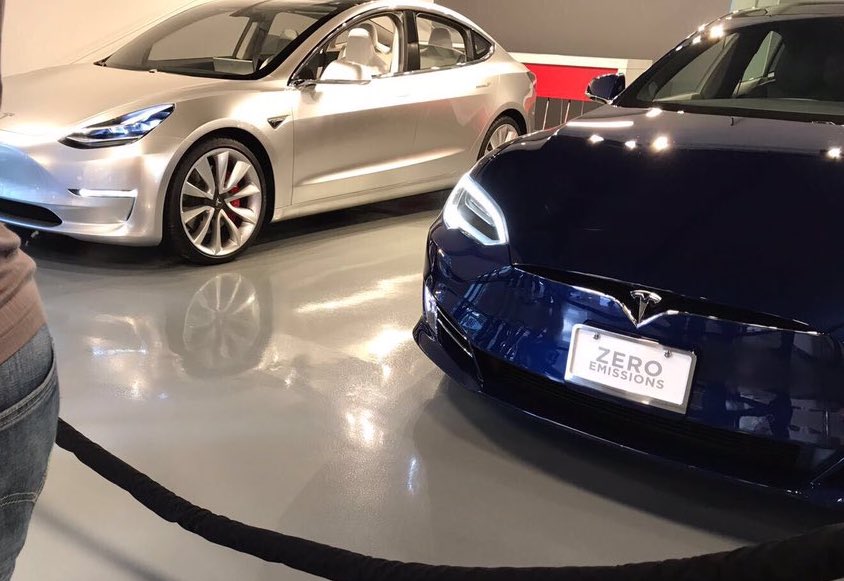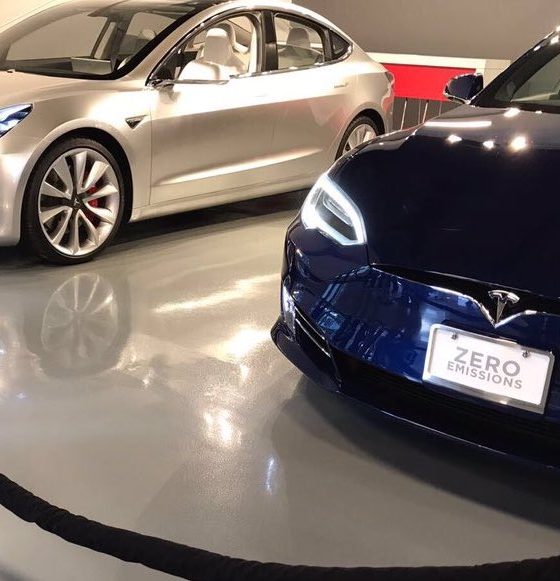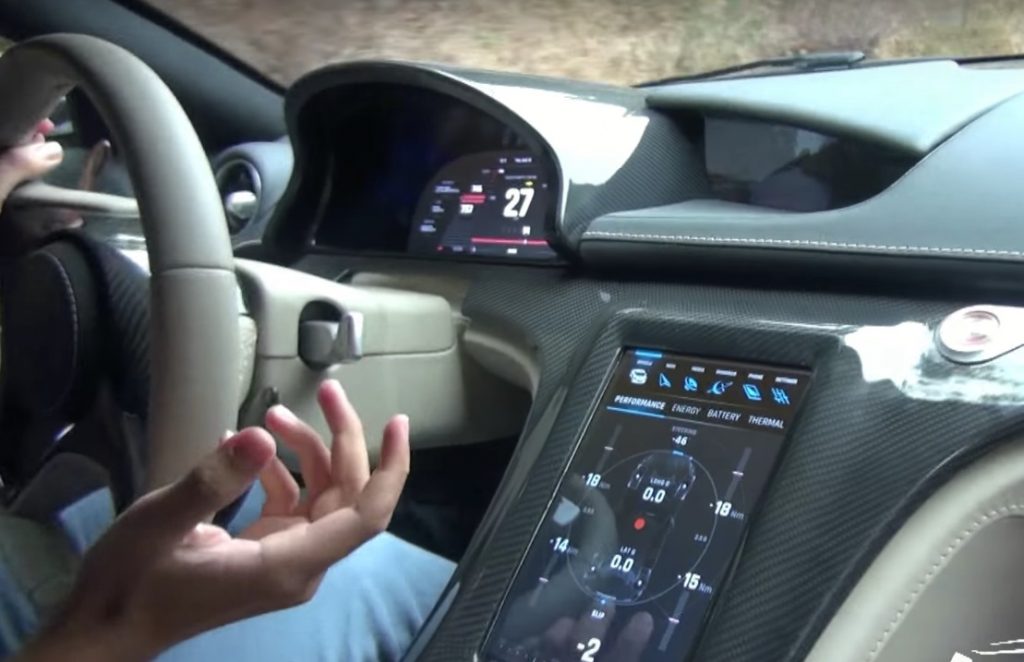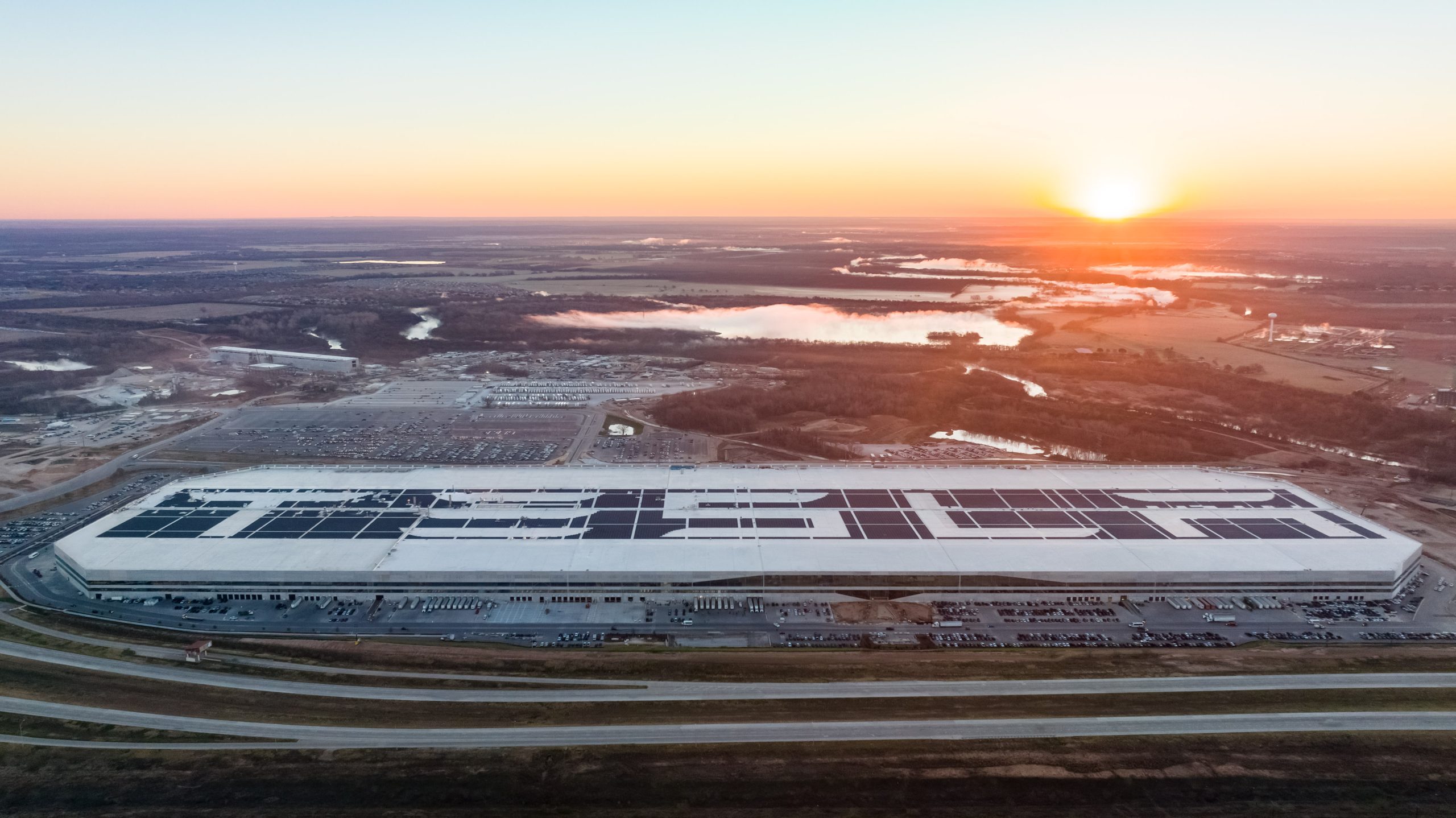

Investor's Corner
Tesla guides EV industry’s shift from niche production to mass market
As Tesla continues to push the boundaries on automation in its factory production line, 2018 could be the year when the company and the electric vehicle (EVs) industry shifts from being seen as niche production to the mass market. Noting that roughly 1.3 million EVs were sold around the world in 2017, a 57 percent increase over 2016 sales, global consultancy McKinsey predicts that EVs’ share of total passenger vehicle sales could reach 30 to 35 percent in major markets like China, Europe, and the US by 2030. In partnership with automotive benchmarking specialist A2Mac1, McKinsey took a deep dive into EV technology, and identified four strategies that automakers should follow to remain relevant as the industry transforms itself.
EVs reached a major milestone in 2017. The main obstacles to mass market adoption have been driving range and price. With the launch of Tesla’s Model 3 and GM’s Chevy Bolt, both of which offer a range of over 250 miles, McKinsey believes that the range issue has basically been solved, and that automakers can now focus on reducing price points, either by increasing design efficiency or reducing manufacturing costs. To be successful at this, McKinsey believes they will need to follow four technical strategies.
1 – Build native electric vehicles
Native EVs – cars built on a custom electric platform, rather than adapted from legacy fossil-fuel vehicles – cost automakers more to develop, but offer multiple advantages. A native EV doesn’t have to be designed around bulky components that are no longer needed, such as drive shaft tunnels and exhaust systems, so it can accommodate a bigger battery pack. The pack can also be placed where it makes the most sense – at the bottom of the vehicle. This “skateboard” design, made famous by Model S designer Franz von Holzhausen, has since been copied by other automakers. Not only does it improve handling by giving the vehicle a lower center of gravity, it also opens up much more space for passengers and cargo.
2 – Push the boundaries of powertrain integration
McKinsey’s benchmarking revealed a continuing trend toward EV powertrain integration: EV-makers are integrating components such as inverters, motor controllers, etc, into fewer modules. One indicator of the increased level of integration is the design of the electric cables connecting the main electric powertrain components (battery, motor, power electronics and thermal management). McKinsey observed a decrease in both cable weight and the number of parts in the latest electric models compared with earlier vehicles.
EV powertrains are inherently more flexible, as the components are smaller, and designers have more freedom to place them in the best positions to optimize space. McKinsey found that the Chevy Bolt seems to use an ICE-like positioning of its powertrain electronics, whereas the Tesla Model 3 integrates most components directly on the rear of its battery pack and rear axle.
3 – Stay ahead in the technology game
Electric vehicle customers tend to be tech-savvy – they expect to have the latest driver-assistance systems, connectivity features and infotainment goodies. This almost obligates EV manufacturers to equip their vehicles with the highest levels of technology available. However, McKinsey sees this as an opportunity, as it creates a great testing field for the new technologies that OEMs and third-party providers are developing.
Vehicle controls are steadily migrating from physical knobs and switches to a more central, smartphone-like user interface. Of course, Tesla’s Model 3 is the ultimate example of this, but most EVs are following the trend of clearing the clutter. “We observed EVs in our benchmark that have as few as seven physical buttons in the interior, compared with 50 to 60 in many standard ICEs,” says McKinsey.

Rimac Concept_One digital controls being demonstrated at Monterey Carweek
Behind the scenes in vehicles’ electronic control units (ECUs), the trend is also toward more consolidation. Legacy autos are controlled by a jumble of different computer systems, often from different suppliers, that talk to each other in limited ways or not at all. Once again, Tesla led the way. In a 2014 interview, Tesla founder Ian Wright told me that his 2008 Volkswagen probably had “sixty or seventy electronic black boxes, 300 pounds of wiring harness, and software from 20 different companies in it.” Tesla’s vehicles use one central computer system. “The major reliability problem with those cars is the electronics and software,” said Wright. “I think Tesla did take a real Silicon Valley systems architecture perspective in designing all the electronics in the Model S.”
In an EV, electronics and software are the heart of the vehicle, and Wright predicted that, as the majors began to produce EVs, they would eventually be forced to adopt a more systems-oriented approach. McKinsey found that this prediction is coming true. Automakers are finding that a centralized approach gives them the chance to own a key control point in the vehicle, helps to save on weight and costs, and may improve reliability. Central, high-power ECUs “could also be the backbone for developing fully autonomous driving.”
4 – Design to cost
Legacy automakers are still struggling to make a profit on their EVs, mainly because of high battery costs (not Tesla, which claims to be earning margins of over 20% on Model S and X sales). Now that the range issue has been more or less solved, McKinsey believes OEMs will need to apply design-to-cost (DTC) strategies to produce EVs at attractive price points while earning decent margins. Fortunately, this something that established OEMs and suppliers are good at, so they may be able to quickly catch up. For example, improvements in battery technology may allow automakers to switch from lightweight but costly aluminum to more cost-efficient steel (a shift Tesla has already made with Model 3).
Can the traditional automakers make money in the volume EV market? Many industry observers are skeptical – one reason for the companies’ reluctance to embrace EVs may be that they see them as a lower-profit proposition. In the first public acknowledgment of this dynamic, Daimler recently announced that it foresees an end to profit growth this year, partly due to the high costs of making the shift to EVs. Certainly, it’s difficult to imagine that any EV will ever yield the prodigious profits of a vehicle like Ford’s F-150 pickup, which has been called the most profitable consumer product in history.
However, McKinsey believes that, if automakers heed its sage advice and take the aforementioned four EV design steps into consideration, they should be able to reduce the higher manufacturing costs of EVs and find their way to a positive mass-market business case. An era of profitable mass-market EVs could be on the horizon, and that would be good news for consumers, the environment – and forward-looking automakers that are willing to take some risks and embrace change.
===
Note: Article originally published on evannex.com by Charles Morris; Source: McKinsey / A2Mac1

Investor's Corner
Tesla stock closes at all-time high on heels of Robotaxi progress

Tesla stock (NASDAQ: TSLA) closed at an all-time high on Tuesday, jumping over 3 percent during the day and finishing at $489.88.
The price beats the previous record close, which was $479.86.
Shares have had a crazy year, dipping more than 40 percent from the start of the year. The stock then started to recover once again around late April, when its price started to climb back up from the low $200 level.
This week, Tesla started to climb toward its highest levels ever, as it was revealed on Sunday that the company was testing driverless Robotaxis in Austin. The spike in value pushed the company’s valuation to $1.63 trillion.
Tesla Robotaxi goes driverless as Musk confirms Safety Monitor removal testing
It is the seventh-most valuable company on the market currently, trailing Nvidia, Apple, Alphabet (Google), Microsoft, Amazon, and Meta.
Shares closed up $14.57 today, up over 3 percent.
The stock has gone through a lot this year, as previously mentioned. Shares tumbled in Q1 due to CEO Elon Musk’s involvement with the Department of Government Efficiency (DOGE), which pulled his attention away from his companies and left a major overhang on their valuations.
However, things started to rebound halfway through the year, and as the government started to phase out the $7,500 tax credit, demand spiked as consumers tried to take advantage of it.
Q3 deliveries were the highest in company history, and Tesla responded to the loss of the tax credit with the launch of the Model 3 and Model Y Standard.
Additionally, analysts have announced high expectations this week for the company on Wall Street as Robotaxi continues to be the focus. With autonomy within Tesla’s sights, things are moving in the direction of Robotaxi being a major catalyst for growth on the Street in the coming year.
Elon Musk
Tesla needs to come through on this one Robotaxi metric, analyst says
“We think the key focus from here will be how fast Tesla can scale driverless operations (including if Tesla’s approach to software/hardware allows it to scale significantly faster than competitors, as the company has argued), and on profitability.”

Tesla needs to come through on this one Robotaxi metric, Mark Delaney of Goldman Sachs says.
Tesla is in the process of rolling out its Robotaxi platform to areas outside of Austin and the California Bay Area. It has plans to launch in five additional cities, including Houston, Dallas, Miami, Las Vegas, and Phoenix.
However, the company’s expansion is not what the focus needs to be, according to Delaney. It’s the speed of deployment.
The analyst said:
“We think the key focus from here will be how fast Tesla can scale driverless operations (including if Tesla’s approach to software/hardware allows it to scale significantly faster than competitors, as the company has argued), and on profitability.”
Profitability will come as the Robotaxi fleet expands. Making that money will be dependent on when Tesla can initiate rides in more areas, giving more customers access to the program.
There are some additional things that the company needs to make happen ahead of the major Robotaxi expansion, one of those things is launching driverless rides in Austin, the first city in which it launched the program.
This week, Tesla started testing driverless Robotaxi rides in Austin, as two different Model Y units were spotted with no occupants, a huge step in the company’s plans for the ride-sharing platform.
Tesla Robotaxi goes driverless as Musk confirms Safety Monitor removal testing
CEO Elon Musk has been hoping to remove Safety Monitors from Robotaxis in Austin for several months, first mentioning the plan to have them out by the end of 2025 in September. He confirmed on Sunday that Tesla had officially removed vehicle occupants and started testing truly unsupervised rides.
Although Safety Monitors in Austin have been sitting in the passenger’s seat, they have still had the ability to override things in case of an emergency. After all, the ultimate goal was safety and avoiding any accidents or injuries.
Goldman Sachs reiterated its ‘Neutral’ rating and its $400 price target. Delaney said, “Tesla is making progress with its autonomous technology,” and recent developments make it evident that this is true.
Investor's Corner
Tesla gets bold Robotaxi prediction from Wall Street firm
Last week, Andrew Percoco took over Tesla analysis for Morgan Stanley from Adam Jonas, who covered the stock for years. Percoco seems to be less optimistic and bullish on Tesla shares, while still being fair and balanced in his analysis.

Tesla (NASDAQ: TSLA) received a bold Robotaxi prediction from Morgan Stanley, which anticipates a dramatic increase in the size of the company’s autonomous ride-hailing suite in the coming years.
Last week, Andrew Percoco took over Tesla analysis for Morgan Stanley from Adam Jonas, who covered the stock for years. Percoco seems to be less optimistic and bullish on Tesla shares, while still being fair and balanced in his analysis.
Percoco dug into the Robotaxi fleet and its expansion in the coming years in his latest note, released on Tuesday. The firm expects Tesla to increase the Robotaxi fleet size to 1,000 vehicles in 2026. However, that’s small-scale compared to what they expect from Tesla in a decade.
Tesla expands Robotaxi app access once again, this time on a global scale
By 2035, Morgan Stanley believes there will be one million Robotaxis on the road across multiple cities, a major jump and a considerable fleet size. We assume this means the fleet of vehicles Tesla will operate internally, and not including passenger-owned vehicles that could be added through software updates.
He also listed three specific catalysts that investors should pay attention to, as these will represent the company being on track to achieve its Robotaxi dreams:
- Opening Robotaxi to the public without a Safety Monitor. Timing is unclear, but it appears that Tesla is getting closer by the day.
- Improvement in safety metrics without the Safety Monitor. Tesla’s ability to improve its safety metrics as it scales miles driven without the Safety Monitor is imperative as it looks to scale in new states and cities in 2026.
- Cybercab start of production, targeted for April 2026. Tesla’s Cybercab is a purpose-built vehicle (no steering wheel or pedals, only two seats) that is expected to be produced through its state-of-the-art unboxed manufacturing process, offering further cost reductions and thus accelerating adoption over time.
Robotaxi stands to be one of Tesla’s most significant revenue contributors, especially as the company plans to continue expanding its ride-hailing service across the world in the coming years.
Its current deployment strategy is controlled and conservative to avoid any drastic and potentially program-ruining incidents.
So far, the program, which is active in Austin and the California Bay Area, has been widely successful.









